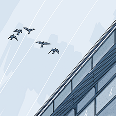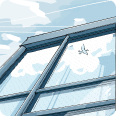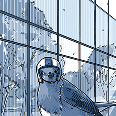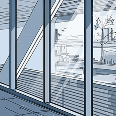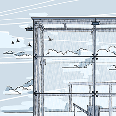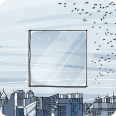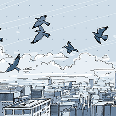Thompson’s bird-friendly glass solutions protect birds, meet regulatory requirements, and deliver the highest quality performance
As an Industry leader in advanced glass and lamination technologies, Thompson Innovative Glass offers customers throughout North America a full line of custom glass products including bird-friendly glass.
Our Quality Management System is ISO 9001:2015 Certified, assuring the highest quality products. With access to a variety of bird-friendly glass and interlayer solutions, Thompson is dedicated to providing the highest quality glass products tailored to each customer’s exact needs.
Our exclusive combination of innovative glass solutions, high-quality fabrication, and expert advice makes us the go-to destination for architects, designers, glaziers, and building owners looking for bird-friendly glass solutions. With Thompson, you are assured of a bird-friendly glass solution that meets your needs and makes our world safer for birds.
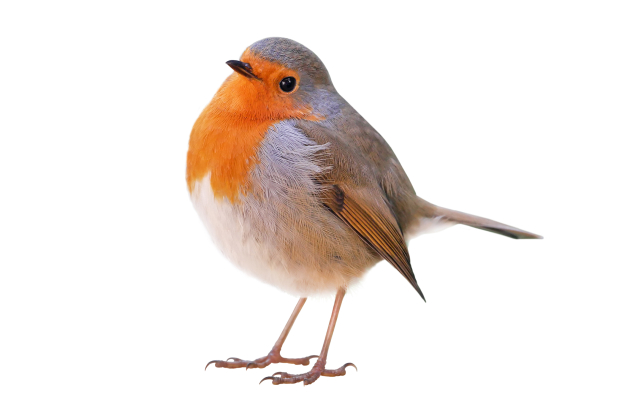
Dangers for birds in an urban environment
As human urbanization increases and natural habitats shrink, animals progressively find obstacles in their path that they are not instinctively familiar with. And with the available space for urban development decreasing, high-rises are more and more common, now also creating obstacles for birds in natural and migratory flight paths. The danger for birds is further amplified by the increased use of glass in architecture.
Dangers for birds
in an urban environment
As human urbanization increases and natural habitats shrink, animals progressively find obstacles in their path that they are not instinctively familiar with. And with the available space for urban development decreasing, high-rises are more and more common, now also creating obstacles for birds in natural and migratory flight paths. The danger for birds is further amplified by the increased use of glass in architecture.
Architecturally, the use of glass provides a valuable connection with the outside, increasing our well-being. Birds, however, do not recognize glass as an obstacle. They see fly-through or reflected habitat conditions or dark areas that seem like passages through which they can fly, often with deadly results.
As glass is increasingly used in design, muting reflections in glass facades and creating visual markers are ways to create more bird-friendly environments.

Two Approaches to Bird-Friendly Glass
Thompson Innovative Glass can utilize multiple Bird-Friendly Glass solutions to meet virtually any project criteria for aesthetics, cost, and bird safety. There are two main pathways to achieve a product that is considered bird-friendly: Performance and Prescriptive.
All of the materials produced by Thompson Innovative Glass fall under one of these headings; with each, a threat factor is generated. A lower threat factor corresponds with the effectiveness of the visible markings (patterns) in reducing bird collisions. The American Bird Conservancy (ABC) defines “bird-friendly” materials as having a Threat Factor less than 30. Please consult local standards/guidelines/codes for more information.

Performance
The Performance path usually refers to an alternative approach, where specific performance metrics are established instead of following strict prescriptive requirements. This approach allows designers and builders more flexibility in achieving the desired outcomes by demonstrating that their design meets or exceeds the performance criteria specified.
Requires bird-friendly products to be tested for effectiveness.
- Requires live bird test subjects
- Relies on test facility availability
Acceptable products must meet a maximum allowable tested metric.
Test protocols and experiment facilities will continue to evolve to keep pace with common glazing solutions.

Prescriptive
The Prescriptive path involves adhering to specific guidelines and criteria designed to reduce bird collisions with glass surfaces. These criteria outline the design specifications, materials, and application techniques recommended by organizations like the American Bird Conservancy. When these three prescribed characteristics are met, no further bird-friendly testing is required for certification.
Either
- A Surface 1 application using an opaque frit or other opaque pattern applied on clear or low-iron glass, or;
- A Surface 2 application using an opaque frit or other opaque pattern applied on clear or low-iron glass where the Visible Light Reflection is <=15%.
As viewed from Surface 1, all Low-E coatings must be behind the pattern.
A pattern that is made up of one of the following elements or a combination:
- Continuous solid lines at least 1/8” wide, nowhere more than 2” apart for horizontal or angled lines, 4” for vertical lines, measured edge to edge.
- Circular, square, or irregular solid shapes that are nowhere more than 2” from another shape vertically and nowhere more than 4” from another shape horizontally, or 4.47” diagonally, measured edge to edge. Each shape must have an area of ≥ 0.049 in2, which corresponds approximately to circles with a diameter of 1/4” (~6mm).
Frequently Asked Questions About Bird-Friendly Glass
What is bird-friendly glass?
Bird-friendly glass is specially designed to minimize bird collisions with buildings. It typically features patterns, coatings, or designs that make the glass more visible to birds, reducing the risk of injury or death.
Why is bird-friendly glazing important?
Each year, millions of birds die from collisions with glass. Bird-friendly glazing helps protect bird populations while promoting sustainable and environmentally conscious building practices.
How does bird-friendly glass work?
Bird-friendly glass incorporates visual markers such as patterns, frits, enamels or UV coatings that birds can see but are minimally obtrusive to humans. These features disrupt reflections and transparency, which are the primary causes of bird collisions.
What are the most common patterns for bird-friendly glazing?
Common patterns include dots, lines, and grids, typically spaced following the “2x4 rule”: patterns are spaced no more than 2 inches apart horizontally or 4 inches vertically to effectively deter birds.
Is bird-friendly glass aesthetically appealing?
Yes. Modern bird-friendly glazing solutions are designed to blend seamlessly into architectural designs, with subtle patterns or coatings that maintain visual appeal.
Is bird-friendly glass compliant with building codes?
Is bird-friendly glass compliant with building codes?
Yes, many jurisdictions have adopted building codes or regulations requiring bird-friendly glass in new constructions or renovations. These codes/regulations do differ by municipality.
What does "Threat Factor" mean in bird-friendly glass?
"Threat Factor" is a measurement used to evaluate how likely a type of glass or glazing material is to cause bird collisions. It is typically rated on a scale from 0 to 100, with lower numbers indicating glass that is less hazardous to birds. Example: The 2022 New York City Building Code mandates that bird-friendly materials used in construction must have a Threat Factor of 25 or lower, as determined by the American Bird Conservancy's Bird Collision Deterrence Material Threat Factor Reference Standard.
Who is the American Bird Conservancy?
The American Bird Conservancy (ABC) is a nonprofit organization dedicated to conserving native bird species and their habitats throughout the Americas. Founded in 1994, ABC works to reduce threats to bird populations and promote sustainable practices that support bird conservation.
ABC developed guidelines for bird-friendly glass and materials to reduce bird collisions with buildings. Their Threat Factor Rating System evaluates the effectiveness of materials in preventing bird collisions.
Can bird-friendly glass still provide energy efficiency?
Most bird-friendly glass products are either designed to be or can be assembled with both energy-efficient and collision-deterrent options. They can include low-E coatings, thermal performance features, and insulation properties.
How is bird-friendly glazing installed?
Bird-friendly glazing is installed similarly to standard insulating glass unit
Are there incentives for using bird-friendly glass?
Yes. Some governments, organizations, and certification programs offer incentives for implementing bird-friendly designs, including tax breaks and LEED points.
Where can I find bird-friendly glass products?
Thompson Innovative Glass features the largest range of options of bird-friendly glass in the industry. No matter the make-up or application we have the solution.
Can birds see glass?
No, birds generally cannot see standard glass. Unlike humans, birds do not recognize glass as a barrier. They often see reflections of sky, trees, or plants and interpret it as open habitat — which leads to collisions. This is why bird-friendly glass is important. It incorporates visual cues (like patterns or UV-reflective elements) that birds can detect, helping them avoid dangerous impacts.
How much does bird-friendly glass cost?
Bird-friendly glass typically costs 15% to 40% more than standard glass, depending on the specific product type and pattern used. Cost factors include:
- The type of visual marker (e.g., acid-etched, ceramic frit, UV coating)
- Whether the glass is custom or standard pattern
- Volume and fabrication needs (tempering, laminating, insulating)
While there’s an upfront premium, many projects benefit from long-term sustainability credits (like LEED) and improved building performance.

Why Choose Thompson
When it comes to bird-friendly glass there are many options. What makes having Thompson Innovative Glass as your partner unique?
As a full-service glass fabricator, Thompson Innovative Glass offers a complete line of glass products, including insulated and laminated glass. This means that projects requiring safety glass and ‘regular’ insulated glass can get it all from the same source.
There are multiple glass-based solutions to help protect the bird population. We are proud to fabricate many of them, ensuring your ability to meet virtually any application, code, regulation, or guideline.
Because Thompson is a full-service fabricator, we can offer customized bird-friendly glass solutions. Customizations can include high-performance Low-E, safety glass, school security, or other specialty glass.
With a large team of dedicated employees, Thompson Innovative Glass has the flexibility to pool manpower where most urgently needed. This results in faster lead times when you need your glass ‘yesterday’.
As a full-service fabricator, we work on ‘regular’ insulated glass as well as on specialty glass products like bird-friendly glass. This translates to zero down-time and lower overhead, resulting in very competitive pricing for you!
With a state-of-the-art manufacturing facility and multi-step inspection procedures and ISO 9001-certified Quality Management Systems, we guarantee high quality.
We partner with our customers. We offer advice, on-site visits, and informational presentations to ensure you have the best solution for your project.


